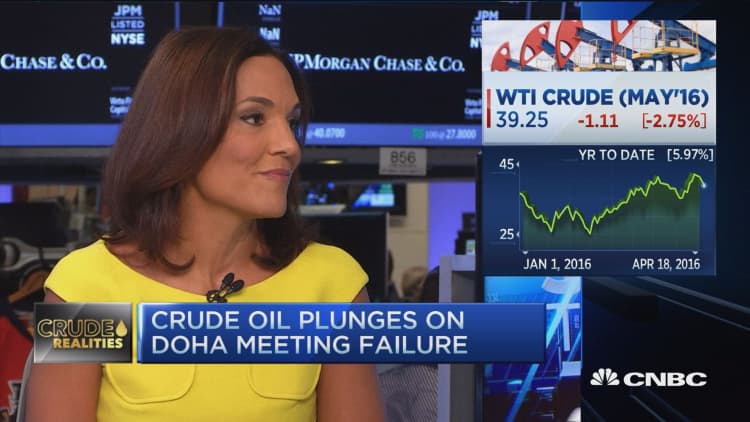


U.S. shale drillers created the world's oil glut, and now they could be the biggest force in ending it.
With the failure of OPEC and other major oil-producing nations to reach a deal to cap output, focus shifts to the U.S. industry's role as a relatively new "swing producer."
"The U.S. has always been a factor. ... It will remain the biggest factor in the rebalancing of the market," said Edward Morse, global head of commodities research at Citigroup. "The U.S. is going to make a disproportional contribution to the market's rebalancing."
Morse said he expects 1.3 million barrels of non-OPEC production to come offline this year, and 600,000 barrels will be from the United States. The U.S. was the biggest force behind the world's oil glut, with the upstart shale industry helping to boost U.S. production by more than 4 million barrels over five years.
The drop in crude prices is hurting oil-producing nations which have been forced to cut budgets amid the sharp drop in revenues. Oil workers in Kuwait this weekend went on strike due to wage and benefit cuts resulting from the decline in prices.
But nonetheless, OPEC and non-OPEC producers this weekend ended their meeting in Doha, Qatar, with no deal to freeze oil output. Saudi Arabia, OPEC's biggest producer, held firm in its position that Iran would have to be part of the deal. But Iran refused to join a freeze and its representative stayed home.
Read MoreSaudis want to inflict more pain on producers: Kilduff
"The big decision from Riyadh is to take decision-making away from the exporters and leave it to the market," said Daniel Yergin, vice chairman of IHS.
The decision also was seen as a clear directive straight from Saudi Deputy Crown Prince Mohammad bin Salman, who has said there would be no deal without Iran. Bin Salman now says the kingdom could even increase its production — by another 1 million barrels a day.
Read MoreU.S. oil output drop is 'buying time'
"What this does is it restates Saudi Arabia's pre-eminence in the world oil market — it has a unique position and flexibility that nobody else has. The current mantra is 'Let the market manage the market,' and the phrase they'll use is 'We'll produce the barrels our customers want.' What this does is it reasserts their power in the world oil market," said Yergin.
Saudi Arabia was the driving force behind OPEC's decision in late 2014 to move to a market-based policy, in an effort to maintain its market share and knock out high-cost production, like U.S. shale.
U.S. production continued to grow for several months after that decision, peaking at 9.7 million barrels a day in April 2015. Last week, output was just under 9 million barrels a day, the lowest level since October 2014. "By some time in the summer, it will be down to 8.3 million barrels a day," Yergin said.
Read MoreThis Saudi millennial could scuttle oil deal
Morse said once production growth restarts after the shakeout, the U.S. should also be the leader in increasing output in 2017 and 2018.
Michael Cohen, head of energy commodities research at Barclays, said talk of the freeze agreement had inflated oil prices by about $5 to $7 a barrel and that has started to come out of the price.
West Texas Intermediate oil futures were trading at $39.86 per barrel Monday, a drop of 1.3 percent. Oil had been off as much as about 7 percent overnight. Kuwait's strike reduced production there by about 2 million barrels a day, and that was seen as a factor supporting oil prices Monday.
Crude prices had risen 55 percent since their lows in February, which came just before producers agreed to discuss a freeze.
Read MoreEnergy stocks fall on Doha deal news
"It's hard to say because everything is intertwined to the extent that dollar weakening was part of it," he said. "There was a significant amount of disrupted oil that came off the market in the last month, whether it was Colombia, Iraq, Nigeria or the rebalancing of U.S. tight oil."
Cohen said the producers may have ironically hurt themselves by driving up the price with deal talk. "We would be two months closer to a rebalancing of the market if we stayed at $35," he said.
Many analysts expect the market to stabilize in the second half of the year, and they still see the potential for oil to reach $50 per barrel by the end of the year.
Read MoreWhy Doha no deal could be good for oil prices
Morse said he projects oil prices to be impacted by the lack of a deal, but they could move up to the low $40s to mid-$40s in the third quarter and reach the low $50s at the end of the year.
"We still expect one way or the other, the price looks like it will be at that $40 to $50 range in the second half of the year," said Yergin. "With the freeze, it would have gotten there earlier ... there's a question about Kuwait, declining U.S. production. Declines elsewhere just because investment slowed down."
The global oil industry continues to overproduce by 1.5 million barrels a day, and supply has to get closer to demand in order for the glut to clear.
Read MoreThe 30-year-old prince who is changing the world
The International Energy Agency last week said that the expected drop-off in U.S. production was beginning to accelerate, and that the oil market could get close to being balanced in the second half of the year.
The U.S. industry is also seeing stockpiles grow but it has now begun refinery maintenance season, typically a period of lower oil demand as refineries get ready to switch to summer gasoline production.


